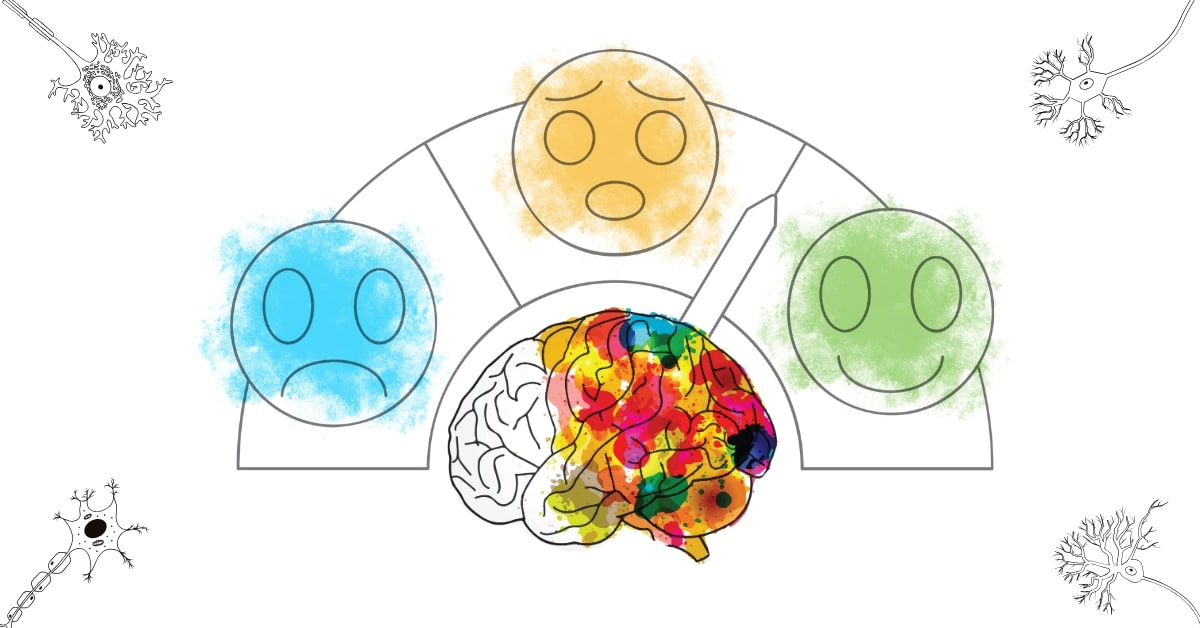When Your Brain’s in All Caps
My phone’s blowing up. My brain won’t shut up. And don’t even ask me what’s for dinner, I might cry.
Sound familiar? Yeah, same. Whether it’s the group chat chaos, that one unread email from a week ago, or just existing in a world that moves at 1000 tabs per second… our brains are fried. Like, “scrolling TikTok while disassociating in a towel for 3 hours” kinda fried.
Here’s the plot twist though: it’s not just anxiety or being “lazy” or “too sensitive.” It’s your nervous system screaming for help like it’s the final girl in a horror movie.
Your nervous system is basically your body’s stress switchboard. When it’s calm, you feel chill, grounded, maybe even capable of answering that text. But when it’s stuck in stress mode (hi, fight-or-flight), you’re tired, irritable, and one minor inconvenience away from rage-crying in the shower.
Good news? You don’t need a yoga retreat in Bali, $80 matcha, or an app that says “breathe in positivity” (cringe). You just need small, simple things that gently tell your body: “Hey, it’s okay. You’re safe now.”
So, if you’re one coffee away from combusting..
Here are 5 tiny, real-life ways to reset your nervous system that don’t require crystals, chants, or pretending you’re not losing it.
Let’s go regulate, bestie.
Quick Crash Course: What Even Is the Nervous System?
Okay, so here’s the deal, your nervous system is like the behind-the-scenes control freak running your whole body. It decides when to panic, when to chill, and when to randomly remember that embarrassing thing you said in 2017.
It’s got two main modes:
- Sympathetic Nervous System = fight or flight.
Translation: “The vibes are off, run!”
Your heart races, muscles tense, digestion? Cancelled. It’s full-on survival mode—even if the “threat” is just a text from your boss. - Parasympathetic Nervous System = rest and digest.
AKA: “We’re safe. Let’s breathe, snack, and maybe cry a little (in a good way).”
This is where your body actually heals and calms down.
Basically, your nervous system has two moods:
“Let’s fight for our lives” and “Let’s nap and digest snacks.”
The problem? Most of us live in panic mode 24/7, and our bodies forget how to flip the switch.
That’s where the small stuff comes in. You don’t need to do a full life rese, just some gentle nudges to help your brain and body remember how to chill the heck out.
1. The 4-7-8 Breath Hack: No, It’s Not a Cheat Code (But Kinda Feels Like One)
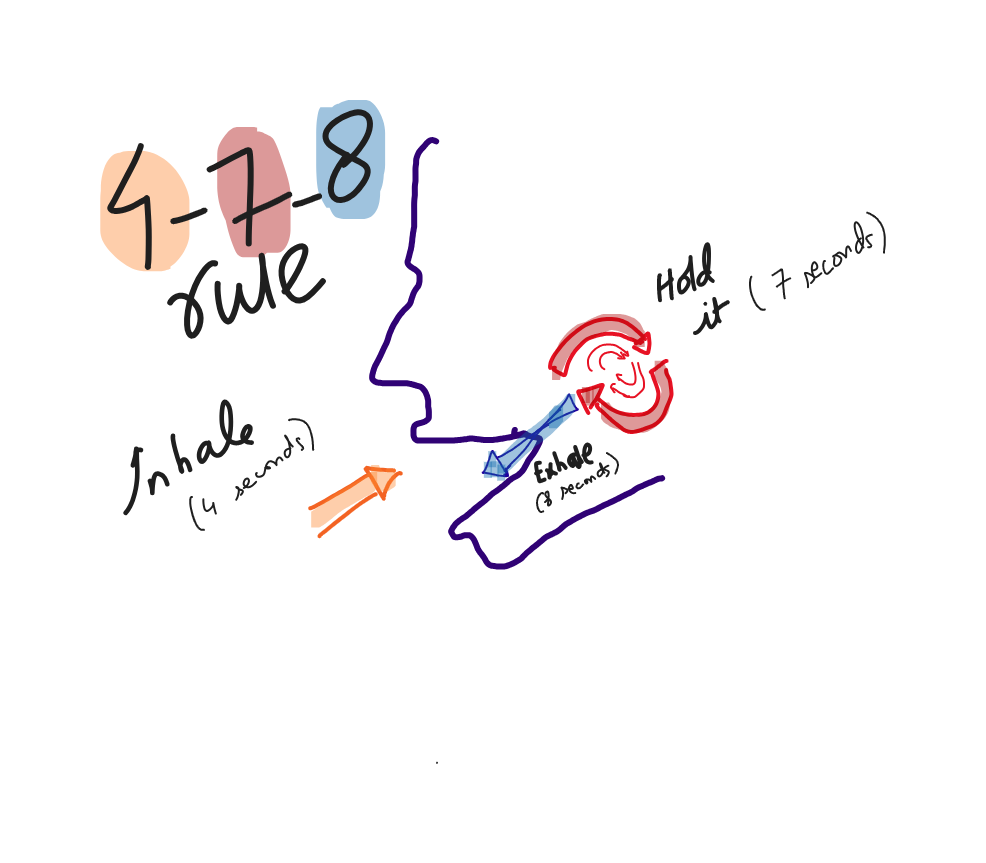
Let me set the scene: You’re spiraling over a typo you made in an email. Your chest feels tight, your brain’s screaming in all caps, and suddenly, breathing feels like trying to sip air through a clogged straw. Been there?
This is where the 4-7-8 breath hack swoops in like the unproblematic fav it is.
It’s dead simple:
- Inhale for 4 seconds
- Hold that breath like your ex is holding grudges, for 7 seconds
- Exhale slowly for 8 seconds
(Repeat 4 times, or until your nervous system gets the “we’re not dying” memo.)
You’re basically tricking your body out of fight-or-flight mode by breathing like someone who’s not freaking out. Science says: deep, slow breathing taps into your parasympathetic nervous system, aka your “chill out, queen” setting.
And no, it doesn’t magically erase the stressor (your inbox still exists), but it regulates your body’s reaction to it. You go from “meltdown in aisle 5” to “okay… I can deal.”
In real life, this looks like:
- Sitting in your car before going into work, doing this instead of doom-scrolling
- Laying in bed overthinking that one convo? 4-7-8 it.
- Bathroom breaks at social events = secret breath hack sessions
Internal feels after a few rounds:
“Okay wait… I actually feel a little less unhinged?? Wild.”
Bonus tip: Try it with your eyes closed while imagining blowing out birthday candles. Add a dramatic sigh if you’re feeling extra. Trust, it hits.
It’s free, it’s quiet, and no one even has to know you’re low-key calming a panic attack during the team meeting.
2. Cold Water Face Splash, Instant Refresh
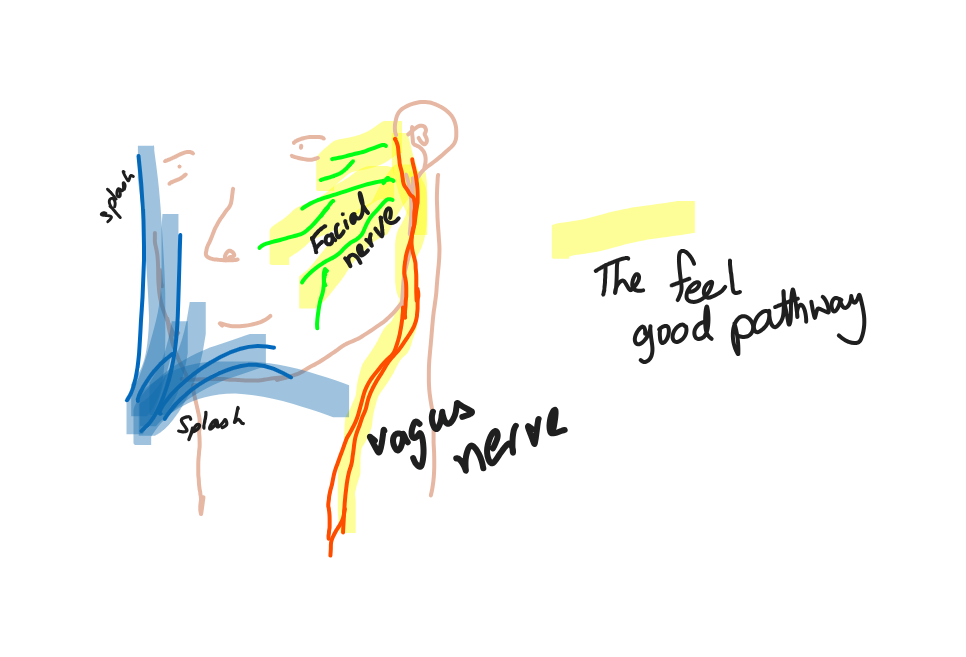
You know that moment when your brain’s buffering, your emotions are Wi-Fi-lagging, and you feel like a human error message? Yeah. Time to throw water at your face like you’re in a telenovela.
Cold water = drama + healing.
It sounds chaotic, but there’s actual science here. Splashing cold water on your face (or pressing an ice pack to your cheek/neck) activates your vagus nerve, which is like the body’s chill button. It shifts you out of panic-mode and into “okay, we’re alive, let’s vibe” mode.
Basically, your body goes:
“Wait. Are we drowning?!”
And then:
“Oh. No. We’re safe. Let’s calm down.”
What it looks like IRL:
- Staring at your reflection like you’re in a breakup scene, then splashing your face with cold water like a dramatic movie lead
- Rubbing an ice cube on your wrists/behind your ears before a stressful convo
- Quick cold shower when your thoughts are spiraling like a cursed TikTok FYP
Internal feels:
“Not me waterboarding myself to feel alive again.”
“Okay, maybe I can make it through this day without quitting my life and moving to a cabin in the woods.”
Bonus tip:
Keep a jade roller or those under-eye metal wands in your fridge. Glide them over your face when you’re spiraling = instant ice therapy but make it skincare. You’ll look like you have your life together even when you absolutely do not.
Cold water isn’t just for waking up. It’s a mini emotional reboot. A little drama, a little splash, a lot of nervous system regulation. Main character energy
3. Move Like You Mean It, Even If It’s Just a Shake-Off Dance
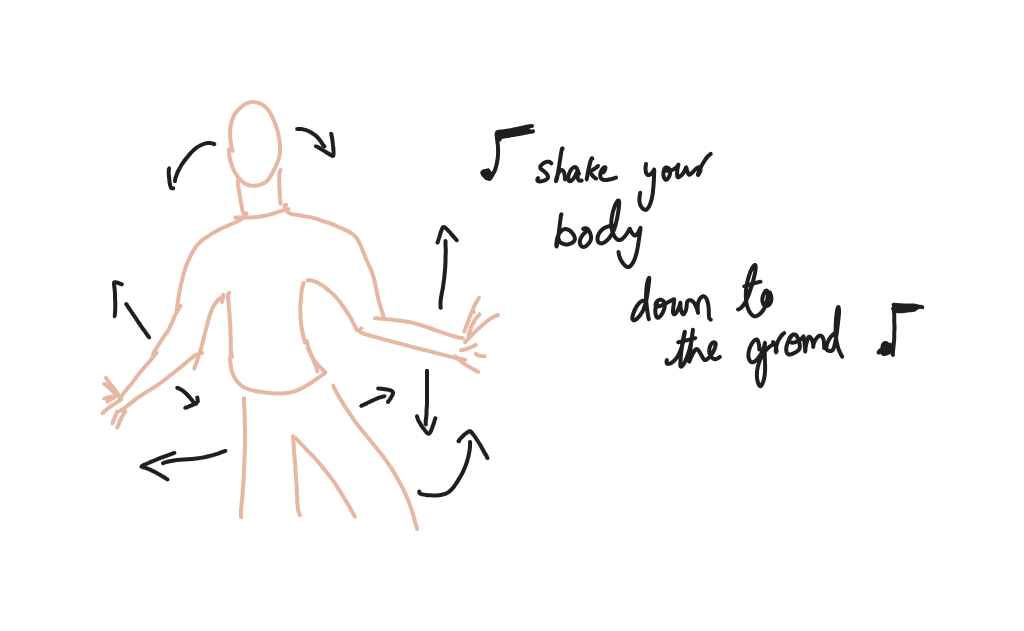
Sometimes, your nervous system doesn’t need a therapist. It needs a rage wiggle in your bedroom at 2 a.m. That’s right movement isn’t just for gym bros and yoga influencers. It’s one of the most underrated, unhinged, and magically regulating things you can do.
When you’re stressed, your body’s pumping out hormones like adrenaline and cortisol aka the “freak out” cocktail. If you just sit with that mess, it stays bottled up like a shaken soda can. Movement? That’s your pressure release valve.
And nope, we’re not talking reps or routines.
We’re talking:
- Jumping in place like your floor’s made of lava
- Flailing your arms like one of those inflatable tube guys
- Doing interpretive dance to sad girl indie pop in your pajamas
- Literally shaking off the day like a wet dog. Therapy!
Internal vibe:
“This isn’t a workout. It’s an emotional exorcism.”
“Am I okay? No. Am I vibing to Beyoncé in my kitchen like I’m performing for the Grammy committee? Absolutely.”
Real life moments it helps:
- When your brain won’t shut up and you need to “dance it out” Grey’s Anatomy-style
- After a tense convo when your body feels like it’s still fighting ghosts
- First thing in the morning when your anxiety’s already awake before you
Bonus tip:
Try a 2-minute stretch or TikTok dance between tasks. You’ll regulate your nervous system and feel slightly more human. Double win.
You don’t need to move perfectly. Just move honestly.
Silly, chaotic, wobbly, whatever. Your nervous system isn’t judging. It’s just grateful you let the energy out.
4. Grounding With Your Senses, Reality Check for Anxious Brains
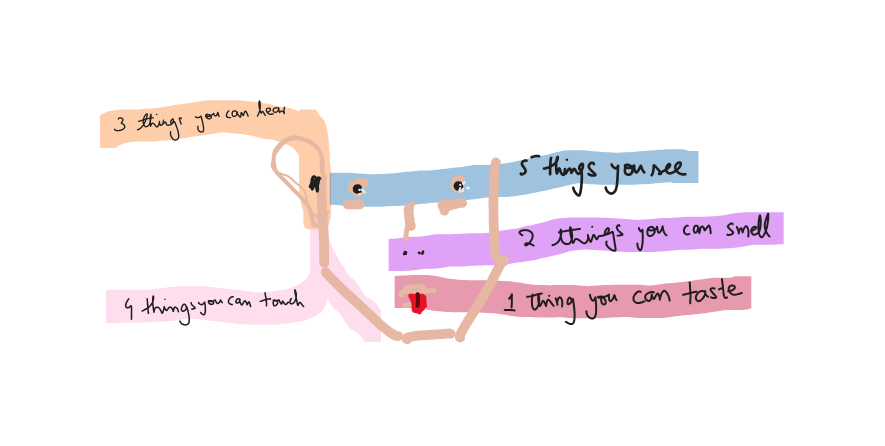
You ever spiral so hard your brain forgets you’re not being chased by a bear? Like, one minute you’re overthinking a text, the next your chest is tight and your soul has left the chat. Enter: the 5-4-3-2-1 method, the reality slap your anxious brain secretly needs.
It’s simple, and no, it’s not just therapy homework. It’s a legit nervous system reset that gently pulls your brain out of panic-parade and back into the “oh right, I’m safe” zone.
Here’s how it works:
5 things you can see (laptop, window, dying plant, half-drunk coffee, dog hair on everything) 4 things you can feel (sweater texture, chair under you, hair tickling your face, sock fuzz)
3 things you can hear (birds, someone’s bad playlist next door, your stomach screaming for snacks)
2 things you can smell (hand lotion? leftover pizza? vibes?)
1 thing you can taste (coffee breath, gum, sadness?)
Internal thought mid-practice:
“Oh hey… I’m not dying. I just needed to notice my socks. Cool.”
This trick works because anxiety lives in the what if, but grounding lives in the what is. It takes you from mental gymnastics to present-moment peace, one sense at a time.
What it looks like in real life:
- Mid-panic scroll, you pause and list what’s around you like Dora the Explorer
- During a social anxiety spike, you touch your jeans and count sounds instead of mentally blacking out
- Lying in bed at 3 a.m. whispering, “Okay brain, let’s name objects like it’s a PBS kids show”
Bonus tip:
Do it in your notes app or whisper it to yourself. It’s weirdly soothing. Almost… meditative? But like, ADHD-friendly.
Your senses are your superpower. Use them to call your brain home.
5. Touch Something Soft, Yes, That’s Allowed
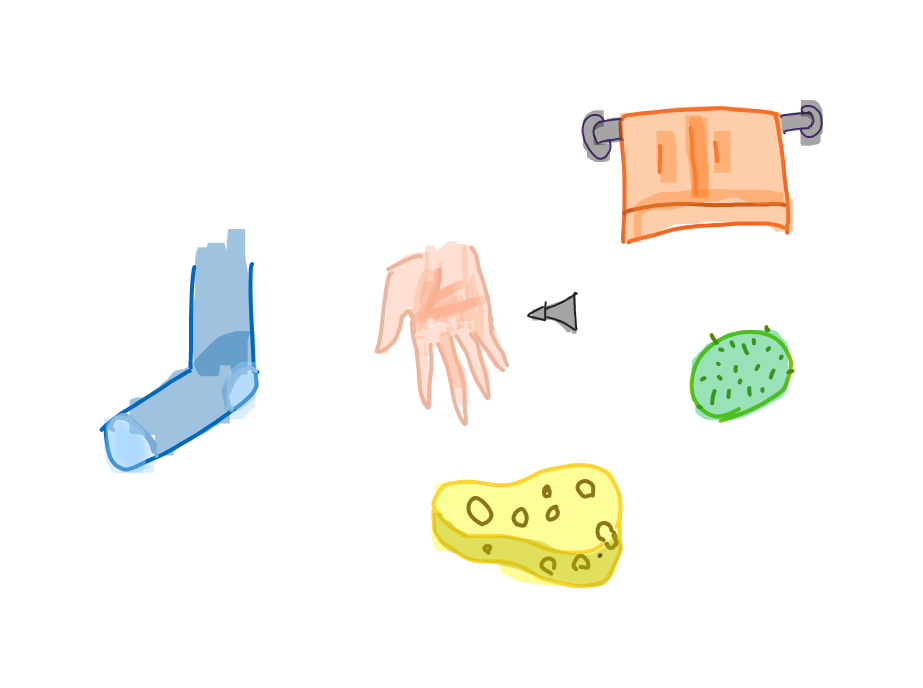
Listen, sometimes the world is just too much. The vibes are off, your brain’s on fire, and your heart feels like it’s tap dancing out of rhythm. You don’t need a TED Talk. You need a blanket. Or a hoodie. Or your dog’s disgustingly soft ears.
Touching something soft = nervous system’s version of a lullaby.
Why? Because your body literally calms down when it feels safe, and safe can look like fuzzy socks, a squishy pillow, or clutching your favorite hoodie like it’s your emotional support ex (but like, way more reliable).
Soft textures activate something called deep pressure touch, which is fancy science for “hug, but make it inanimate and socially low-maintenance.” It lowers your cortisol (aka the stress hormone), slows your heart rate, and makes your nervous system whisper, “Okay fine, maybe we’re not dying.”
What this looks like in real life:
- Wrapping up in your blanket burrito at 3 p.m. like the day just personally attacked you
- Petting your cat like a Victorian villain processing betrayal
- Wearing the same soft hoodie four days in a row because it’s the only thing keeping you tethered to this plane of existence
Internal vibe:
“My weighted blanket doesn’t judge me. My weighted blanket gets me.”
Bonus tip:
No blanket? No problem. Try a warm bathrobe, those weirdly comforting fuzzy socks, or even just running your hand over a soft pillow or your own arm. (Yes, self-soothing is valid. Yes, you’re allowed to feel comforted by anything that doesn’t hurt you or others.)
Because sometimes the reset you need isn’t a mindset shift, it’s just a really good snuggle.
Why Little Things Work (Even If They Feel Kinda Silly)
Here’s the deal: your nervous system? It’s not out here asking for a five-star spa day or a personality makeover. It just wants consistency. Tiny, gentle reminders that you’re safe. That you’re not in a bear fight. That life isn’t actually spiraling, your brain just thinks it is.
These small resets like breathing for eight seconds or hugging your favorite pillow like a koala—might look low-key ridiculous. But to your nervous system, they’re powerful. Like, “hey bestie, we’re not under attack” powerful.
Because healing isn’t always deep talks and shadow work. Sometimes, it’s just remembering to drink water and breathe like a human.
No shame in that. No shame in soft things, silly dances, or crying into your hoodie. These aren’t baby steps. They’re brave steps.
If you’ve been running on burnout, it makes sense that your body freaks out. But those little moments? They rewire the freakout. Slowly. Steadily. Gently.
So the next time your brain goes DEFCON 1 over a group text or a meeting invite, pause. Try one small thing.
It’s not weakness. It’s regulation. And it’s valid as hell.
You’re Not “Too Sensitive”, You’re Just Human
This world is loud, overstimulating, and basically a sensory nightmare half the time. You’re not weak for feeling it, you’re tuned in. That’s not a flaw. It’s actually kinda powerful.
So normalize needing to reset. Build your own nervous system care kit: soft things, safe people, deep breaths, and go-to rituals that make your brain go “ahhh.”
Because guess what?
You’re not dramatic. You’re just finally listening to your body, something most people forgot how to do.
And that? That’s the real flex.
A passionate psychologist on a mission to make psychology insightful, relatable, and engaging! From mental health to human behavior, I break down complex ideas into thought-provoking reads for curious minds.

